GG's Selfie
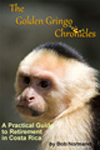 |
Would you like to read the Chronicles in a narrative format
as a hard-copy novel
or an e-book?
If so, go HERE
Broken News
(All the News That's Fit to Reprint)
How to Fly to Costa Rica - FREE
At least this is what happened to 150 people who did it as recently reported by QCostaRica.
 jetBlue Airways is a relative newcomer (2013) to Costa Rica (evidently their trademarked logo begins with a lower case "j" - I would think that must cause a little angst in some grammar circles). The airline keeps expanding its schedule here and now services both San José and Liberia international airports from New York and Ft. Liquordale (er, excuse, Ft. Lauderdale). To encourage jetBlue awareness of their service to Ticoland amongst customers and potential customers, a public relations promotion was recently done on a jetBlue flight from Boston to Phoenix.
jetBlue Airways is a relative newcomer (2013) to Costa Rica (evidently their trademarked logo begins with a lower case "j" - I would think that must cause a little angst in some grammar circles). The airline keeps expanding its schedule here and now services both San José and Liberia international airports from New York and Ft. Liquordale (er, excuse, Ft. Lauderdale). To encourage jetBlue awareness of their service to Ticoland amongst customers and potential customers, a public relations promotion was recently done on a jetBlue flight from Boston to Phoenix.
jetBlue Flight 603
Happy Flyers
 |
Here was the deal: "If all the passengers can agree on one single location that jetBlue flies to, all passengers on this flight (#603) will get a free round trip ticket to that destination." (Dude, why don't I get these flights?) After considerable negotiation amongst the passengers, and the popular destination Turks and Caicos coming in a strong second (like Ted Cruze), the group decided on Costa Rica as their unanimous pick. jetBlue then handed out 150 coupons to the lucky passengers. I bet that made some permanent jetBlue customers.
To see the video of the award process in flight, go here: https://youtu.be/EPurzKVTlU4
Nica Canal Still Abuilding, Says Nicaragua
The latest press releases from the Nicaraguan government say that studies are progressing in anticipation of building their 276 km (165 mile) Atlantic-Pacific canal. Current focus is on "...geological, cartographic, topographic and high definition photographic studies that include the 10 km wide canal strip and the Cocibolca Lake perimeter."
The Chronicles has followed this project since the first announcement of its inception back in June 2012; for a history of our reports, go here: Nica Canal Stories.
This canal seems to be the personal brainchild and favorite project of the Nicaraguan president, Daniel Ortega and while many would give pause at the significant barriers to overcome, including a minimum $50 billion price tag in a country with an $11 billion GDP and $1.6 billion national budget (and even that is running at a 13% deficit). But Ortega won't be dissuaded easily. The Chinese are supposed to pay for this ditch but my guess is their recent fiscal reverses will at least cause a substantial delay. And now environmentalists are raising concern because the route cuts a swath 10 km (6 miles) wide (shown above), going right through the heart of two nature reserves and two lakes including Lake Nicaragua (Cocibolca). This great lake also happens to be the feeder for the major aquifer that supplies much of Costa Rica's ground water so Ticos feel they have a stake in what happens with this project.
Keep tuned, certainly there's more to be revealed.
Gas is Going UP - Surely You Jest?
Fast on the heels of last month's announcement of an historic drop in gasoline prices, RECOPE (Refinedora Costaricense de Petroleo), the national refining company and ARESEP (Autoridad Reguladora de los Servicios Públicos), the government agency responsible for setting commodity prices, announced this month that there will be an increase next month. Regular gasoline is currently 424 colones per liter (just about $3.00 per gallon). It's now scheduled to go up to 463 colones or $3.28 per gallon. It never dropped below $3 per gallon trying to catch up with the low world oil prices (U.S. - Florida was averaging $1.78/gallon last month).
One reason the gas price here doesn't reflect world oil prices is that the tax on a gallon of gasoline here is 233 colones or $1.65 or 55% of the pump cost (in Florida it's about 37 cents on $1.78 or 21% of pump cost.
So I learned, they're not jesting about the increase.
Coffee Talk
Example of High Priced Export Coffee
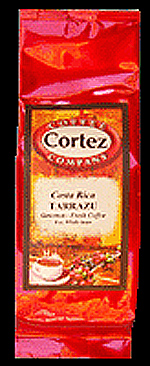 |
Any true coffee lover would quickly agree that Costa Rica produces some of the best coffee in the world. Starbuck's must agree with that also as the last time I checked they were getting about 30-40% of their worldwide consumption from Costa Rica coffee farms.
So it was interesting to read in a daily electronic newspaper that Costa Rica actually imports coffee to meet its own consumption demand. Last year some 11,500 tons were imported equal to about 12% of national production. The major reason for the need to import is that much of the export business is done at higher prices so export orders get filled first and with the best beans. (I wonder if ARESEP controls the domestic price of coffee also? - hmmmm)
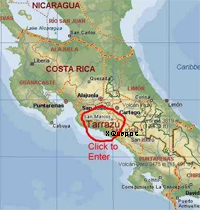 There are a myriad of brands that are exported and many of them come from the Tarrazu region. Tarrazu is a canton (a canton is like a county and Tarrazu is a canton of San José province like Quepos is a canton of Puntarenas province). While other provinces produce their own variety of quality coffees, Tarrazu is considered the source of some of the best along with neighboring regions like Dota.
There are a myriad of brands that are exported and many of them come from the Tarrazu region. Tarrazu is a canton (a canton is like a county and Tarrazu is a canton of San José province like Quepos is a canton of Puntarenas province). While other provinces produce their own variety of quality coffees, Tarrazu is considered the source of some of the best along with neighboring regions like Dota.
GG has always been a devotee of the hot water extract of the roasted and ground berries of the coffea plant, better known simply as coffee. A flurry of reports in the last few years extolling the health benefits of coffee have only reinforced my romance with the drink. The fact that we have so many delicious brands available to us locally is just a schweeeet thing.
Quepos Quickies
MA High on Central American Beach Rankings.
Trip Advisor is a well known online service that rates places to stay, restaurants and other tourist facilities around the world. It recently released its ranking for beaches in Central America, reportedly based on input from millions of tourists.
West Bay Beach Honduras, Voted #1
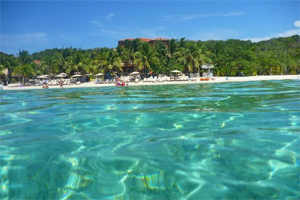 |
Not surprising to this beachophile, five of the top ten Central American beach rankings were in Costa Rica. Number one was West Bay Beach on Bay Islands in Honduras. See the photo right - not surprising when you look at that beautiful, crystal clear caribbean water - GG hasn't seen anything like that since San Andres Island in Colombia!).
Coming in second on the list was our own Manuel Antonio beach. The other four top beaches in Ticoland were Nosara (#3), Playa Santa Teresa (#4), Avellana (#5) and Playa Hermosa in Santa Teresa (#6). Note that #3-6 are all on the Nicoya peninsula. I've been to Santa Teresa and scenery is outstanding but I find the water and Pacific waves more suitable for surfers than old gilded dudes. One advantage MA has is mucho better roads for access (see the report on our visit to the Nicoya last year).
Oh, so many good choices, so little time.
Bus Fare Decreases Again.
On the heels of the dramatic decline (he says, tongue in cheek) of 320 down to 310 colones in local bus fares for the Quepos-Manuel Antonio Line last December, another fare drop occurred in March. The new fare is 305 colones, down 5 (0.9 U.S.¢). My oh my, talk about micro-managing. Don't spend all those savings in one place amigos. For background information, the fare when I arrived here in September of 2008 was 160. On the other hand amigos, don't spend that savings at all because, with the price of gas going up (see Surely You Jest article above), the fare is likely to be micro-managed upward again and shortly.
GG continues to be grateful that he doesn't have to pay the local fare because he's an old dude and has an official residency document (cédula). Nyah, nyah, nyah; thanks my Tico amigos.
Rumble Talk
(Eruptions from Key Volcanoes Continue)
The central american spine of volcanoes that runs through western Nicaragua and Costa Rica (you know, that ridge that actually formed the central American isthmus some 4,000,000 years ago) continues to be active these days.
Costa Rica's Turrialba
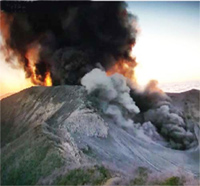 |
Nicaragua's Momotombo
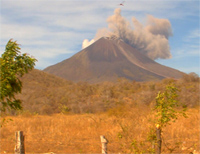 |
In Costa Rica, volcan Turrialba, which began its series of eruptions in 2010, continues to periodically throw large amounts of ash into the nearby countryside. It also causes acid rain which destroys local crops. Tourism has been effected because of a two kilometer safe zone established around the mountain which caused closure of Turrialba National Park.
About 400 kilometers (250 miles) northeast of Turrialba as the toucan flies, volcan Momotombo in Nicaragua, which recently awoke from a 110 year hiatus, continues to periodically throw ash and "incandescent material" into the air up to a kilometer high. Momotombo is located north of Managua just above Lake Xolotlán (Lake Managua - see map in the article above on the great canal). On the last Sunday in February there were two strong explosions, bringing to 71 the number of eruptions that have registered on seismographs since December 1st of last year.
The good news may be that these eruptions are relieving pressure along the Pacific Rim making it less likely that such relief will come via severe earthquakes. Let's hope that's the case.
Check Out Recent Earthquakes Around the World
Posted by the U.S. Geodetic Survey: Today's Quakes |
Search the Golden Gringo Chronicles Archives for Topics That Interest You
You can use our Archives to explore over 180 feature articles of the Golden Gringo Chronicles plus find Broken News items and ROMEO restaurant reviews. Enter your topic or item to search for in the Google Search Routine below and follow the links offered from the search results. Suggestion: Enter only a simple and precise keyword or two in order to narrow the number of references retrieved:
Golden Gringo Chronicles - Enter Search Here
¿Que Es Eso? Department
(Vanity, Thy Name is Gecko)
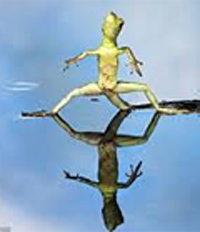
Why is This Gecko Looking Into a Mirror?
(This is a Photo of a Real Reptile)
Answer in What's-in-Word Section Below.
San José Club Union
(In the Heart of Things)
GG finds himself wandering San José more often these days because of visits to medical facilities and also to meet associates monthly in a certain writer's group where we give each other helpful tips, which I need and appreciate. In the early years living here I would find myself in "Chepe" (Cheh-pay, Spanish slang or nickname for Joseph and often used for San José) two to three times per year, but now the frequency is more like once per month.
The Directo bus from Quepos to San José stops only twice, about 14 miles north of Quepos in Parrita, to pick up passengers and then again for a 10 minute nature break and snack grab near the entrance to the autopista (expressway) in Pozon, near Orotina. Nevertheless, up and down in one day can absorb up to seven hours of an old geezer's time and be quite tiring. So I've taken to staying over, usually for one night, and returning the next day. That, of course, provides more time to explore San José.
Cafe Club Union
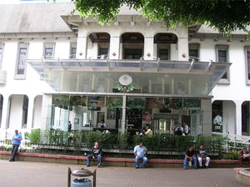 |
So one day at lunchtime I was walking on Avenida Central when I recalled an advertisement in a daily electronic newspaper I peruse, would you believe, daily. It was called the Club Union Grill and I looked up the address on my trusty semi-smart phone, finding that it was located between Avenida 1 and Avenida 3 on Calle 2.
I was staying at a hotel on Avenida Central near Calle 3. I quickly ascertained that I would need to walk three blocks west towards La Sabana park, turn right and go one block north (if you're not familiar with the unusual east/west-odd/even street, south/north-odd/even avenue numbering system in San José, don't bother to try and figure out the arithmetic of the numbers above - just trust me, it was three blocks west, one block north). It was an easy walk from my hotel which is located near the absolute tourist center of San José, the Plaza de la Cultura and the Teatro Nacional.
"Distinction and Elegance
Since 1923"
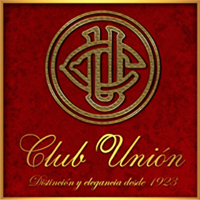 |
I arrived to find the glass-walled cafe shown in the photo above. I assumed a position inside the grill sitting along the glass wall and I quickly noticed the classic buildings around me. So I began asking the wait staff some questions. The name "Club Union" struck me as kind of old world (for aging gilded dudes like me, that's prior to 1960). The look of the building to which it was attached reminded me of an old men's club in Chicago, the Union League Club, where I sometimes stayed in the 1970's when visiting my company's headquarters on Michigan avenue a few blocks away.
Being in the heart of the Costa Rican capital, GG asked: "Might I assume that this is, or was, a long-existing men's club where pols and influential business people gather? "Exactamente, Senor, said my waiter". I watched with interest during the hour and a half I was there and noticed that the people coming into the grill were in formal business suits or business dresses and were well coifed. Yes indeed, I must be in the heart of San José at business lunch time.
Juan Rafael Mora
Porras
Outside Club Union
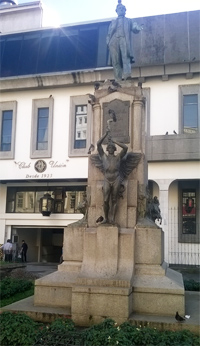 |
There was much else to consider also. I noticed that in front of the main entrance to the club proper (left) was a statue and I learned that the statue is of Juan Rafael Mora Porras, a coffee baron who ended up president of the first republic from 1849-1859. It was during that period that Mora's government won formal recognition of Costa Rica's independence from Spain although declaration of independence from Spanish rule occurred some 30 years earlier. See History of Costa Rica.
In addition it was during Mora's term that Costa Rica came under the threat of filibusters (i.e., American military adventurers, not excessive talkers). A fellow by the name of William Walker, a Philadelphia lawyer and egomaniac, fresh from being kicked out of California for trying to make himself King there, marched with his rag-tag army south to become President of Central America. He was soundly defeated by a small Costa Rican army sent north of the border into Nicaraguan at the town of Rivas.
That battle (April 11, 1856) is celebrated as an important historical event in Costa Rica and produced a young Tico hero named Juan Santamaria who gave his life in the process. In his honor, Juan Santamaria is now the name of the largest international airport in Costa Rica located near San José in Alejuela.
Correo Central
de San
José
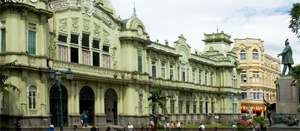 |
Another building that you can't miss while sitting in the Club Union Grill is directly across the street, 2nd Street that is, which is a walking street in that area. This is the Correo Central or Central Post Office of San José (photo right - that's the Mora statue to the far right). This building is one of the more architecturally interesting buildings in San José and was built in 1914-1917 by a British construction firm under a contract for £27,000 (about $3 million in today's dollars).
Christmas at the Correos
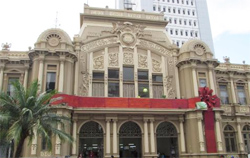 |
If you look closely at the neoclassical facade over the door of the Correos you can see the words "Correos" and "Telegraphie" molded into the cement work, indicating the two main purposes for its existence. The picture to the left shows the facade a few months ago decorated for Christmas.
The Correos building housed several ministries over the years but as the government grew these ministries found more spacious quarters. The upper floor of the building now is home to the Philatelic Museum, which contains displays of all the Costa Rican stamps and seals (Costa Ricans love stamps and seals, just get any document officially approved and you'll see).
The Club Union itself is a study in old world elegance and charm; GG has yet to have a dinner there but it's definitely on my bucket list. Just check out the brief montage below to see what I'm talking about. Maybe, our President, Señor Solis is available for conference; I'll have my people check with his people.
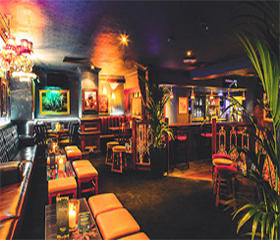 |
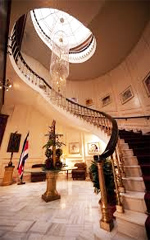 |
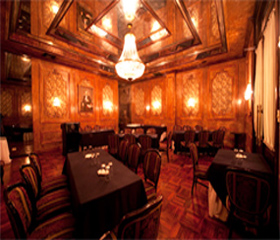 |
The Bar at Club Union |
Staircase |
Conference Room |
So, GG suggests to the reader not to wait as long as he did to find out more about San José and what it has to offer. There's plenty to see and learn.
(to read more on the downtown San José area in the best English guide available, check out Michael Miller's "The Real San José" and his website at www.therealsanjose.com)
¡Solo Bueno!
TOP
The Last Cacique
(Chief of the Firewater)
Note: This article frequently uses the term "indiginas", a Spanish descriptor with Spanish pronunciation "een-dee-hee-nahs", to describe the native americans that occupied Costa Rica before, during and after the Spanish occupation.
Archaeological evidence dates the arrival of the first humans in Costa Rica to between 7000 and 10,000 BC, relatively late compared to other continents. By 1500 BC, sedentary farming communities already existed here. By 300 AD many communities had evolved from a tribal, clan-centered organization that was based on kinship to a hierarchical system with caciques or chiefs as primary leaders, plus religious leaders, shamans, artisans and other specialists.
Cacique Sitting on Throne (ca 1000 AD)
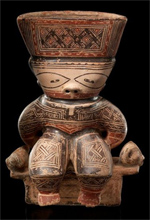 |
From 300 AD to 1000 AD the population and number of tribes increased substantially and the hierarchal structure did likewise. While the cacique was the dominant leader of the tribe, he became obliged by evolving tradition and an unwritten democratic code to consult with his council of elders or, as some came to be known, the huehues (way-ways or hway-hways). These councils consisted of warriors, priests or shamans and other prestigious elders in the community. The basic government structure of a cacique and council, would be in use until the Spanish arrived some 500 years later. Remnants of this type of organization still exist in remaining indigina tribes today.
Ceramics, like the chocolate pot shown in the photo right, reflected the importance of the Cacique. Chocolate has long been considered by the American continental indiginas (and GG) as a sacred beverage. (see Montezuma)
Gerard Depardieu Playing Columbus in 1992 Film: "1492 - Conquest of Paradise"
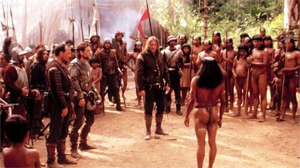 |
Costa Rica was first visited by the Spanish when explorer Christopher Columbus dropped anchor off Limón in 1502 on his fourth and last trip to the new world. The indigina population of what is now Costa Rica at that time is estimated to have been between 20,000 and 35,000 while today the number is estimated at somewhat less than 70,000. During that time the non-indigenous population here has grown from zero to over 4.5 million. The exact number of indiginas remaining today is not clear because the several tribal reservations still are autonomous and many remain undocumented although efforts are underway by the national government to register all the people. This, of course, is resisted by some of the indiginas.
The first visits of Spaniards to Costa Rica were friendly encounters by both parties but in subsequent visits expedition forces began setting up settlements on the caribbean coast and later additional Spanish expeditions started coming up from Panama and Colombia on the Pacific side as well. The reaction by the indiginas was at first to retreat into the protection of the mountains but they soon realized they would need to confront their problem directly. Unfortunately, both conquerors and conquered also quickly realized that the indiginas were greatly outclassed in weaponry and would suffer eventual defeat and subjugation. Despite their most furious and violent resistance, the indiginas were quickly overcome by the invading forces and would, sometimes brutally, be vanquished and in many cases enslaved, during the three hundred years of Spanish occupation.
Cacique's Gold Ornaments
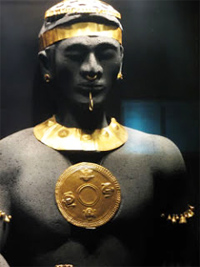 |
Costa Rica was not made a province of Spain until 1560, 58 years after Columbus' first arrival, because the country offered difficult terrain that dissuaded explorers and because no significant deposits of easily extractable gold were ever found here like those found to the north (Mexico) and south (Peru, Chile). This despite the first visitors naming the area the "Rich Coast" after observing substantial amounts of gold ornaments on the bodies of the natives on the Caribbean coast (see Columbus Arrives).
The indiginas, particularly those that had emigrated here from the south, had learned the special arts of working metals and brought their techniques with them. While there were some gold nuggets to be found in the nearby rivers and streams, much of the raw material was likely to have been obtained by trading. Trading had developed into a regional practice and many came from various tribes and people all the way from southern parts of Mexico down to northern South America.
These periodic trading meetings offered the opportunity for locals to trade some of their specialties in exchange for the precious metal from indiginas much richer in gold deposits than Costa Rica. Many of the gold pieces fabricated in Costa Rica also contained some copper which was prevalent in the rocky volcano areas. It made working in combination with gold even easier and extended the gold.
Statue of Pablo Presbere
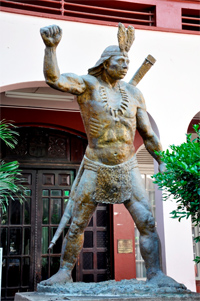 |
For the next 260 years, well into the 19th century, the Spanish ruled with an iron hand. There were many rebellions by the indiginas that were put down by the overlords including a famous one in 1710 led by a cacique of the BriBri, one Pablo Presbere (also know in the bribri language as Pabru Presberi). Presbere had the support of many tribes in Costa Rica during this rebellion. In the initial stages of the 1710 rebellion, several monks and soldiers and the wife of one soldier were killed, In addition, fourteen churches were torched that had been erected by the missionaries. When Presbere was caught in the province of Cartago he was beheaded and the remaining indiginas were sent to isolated camps in the Talamanca region.
Antonio Saldaña
The Last Cacique
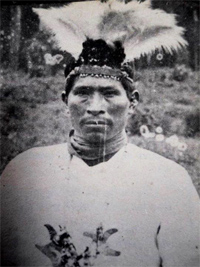 |
By the 1860's the Costa Rican government was concerned with English adventurism, particularly the possibility of the port of Limon becoming an export center controlled by the British empire. The government sought out alliances with the various indigenous tribes and appointed three caciques as political leaders in 1867. In the ensuing years, the three chiefs and their families engaged in political intrigue among themselves, the governor arresting one, then appointing another, but in 1880 the man who would be the last cacique in Costa Rica, Antonio Saldaña, was appointed.
Saldaña tried to govern but often found himself operating in the difficult middle ground between a government that wanted to impose their own culture and traditions on the indiginas, and rebellious tribes. He was set up as king over 3,000 indiginas that were members of several tribes (Bribri, Cabécares, Teribes, Changuinolas and Borucas). Besides the people's desire to rebel, there also was the problem of the Banana Company, whose presence in the region angered the natives and often resulted in the sabotage of plantations and railways.
A "Cachumba"
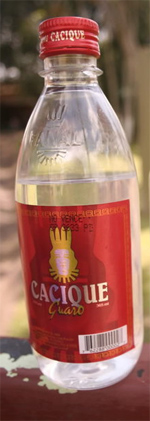 |
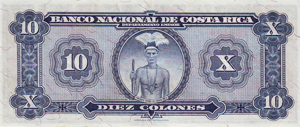 In 1910, cacique Saldaña attended a funeral feast and he and his nephew, who was scheduled to succeed him, died by poisoning at the event. The official report stated that they died by drinking iodine accidentally but oral tradition among the indiginas claims it was intentional. There was never another cacique appointed after Saldaña. In 1939, the last cacique was honored by putting his image on the ten colon paper bill (one colon in 1939 was equal to $3.63, so ten would be $36+). This was before the civil war and some 9 years before the founding of the Costa Rican second republic, the basic government structure that continues to this day.
In 1910, cacique Saldaña attended a funeral feast and he and his nephew, who was scheduled to succeed him, died by poisoning at the event. The official report stated that they died by drinking iodine accidentally but oral tradition among the indiginas claims it was intentional. There was never another cacique appointed after Saldaña. In 1939, the last cacique was honored by putting his image on the ten colon paper bill (one colon in 1939 was equal to $3.63, so ten would be $36+). This was before the civil war and some 9 years before the founding of the Costa Rican second republic, the basic government structure that continues to this day.
While there are no more chieftains like the caciques of old, the name has not completely fallen out of use. The government some time ago decided by law that it, itself would be the single manufacturer and seller of guaro, a distillate of cane sugar. They selected "Cacique" as the brand name for their product. The stuff is 70 proof, clear, inexpensive and I have no idea, nor want to learn, what it tastes like (hic). A "cachumba" or 500 ml plastic bottle of Cacique sells for about 2,500 colones (~$4.70), a pretty cheap drunk, and is the beverage of choice among many of the street drinking class in Quepos.
GG found the middle-ages period in Costa Rica, 500-1500 AD, so intriguing that he has begun research on a book, the story of which will take place around 1000 AD, long before the Spanish arrived but during the time that might be dubbed the golden age of the indiginas. The story line envisioned is to incorporate some of the great legends of Costa Rica such as the Legend of Zurqui and the Legend of Turrialba into a love story that involves the daughter of the cacique of one tribe falling in love with the son of the cacique of another. The only problem is both tribes are historical enemies and the caciques have other matches in mind for their heirs apparent. It's sort of a Romeo & Juliet meets Hatfield & McCoy thing, Costa Rican style.
Research has moved rather slowly because, once you get past the pottery shards of the archaeologists, detailed information on the lifestyle of the indiginas in the middle-ages is scarce.
The initial title of the new book is "Mariposa, A Love Story of Costa Rica". This is GG's first attempt at fiction so wish me luck and look for publication in the third or fourth quarter of 2016.
¡Pura Vida!
TOP
Semana Santa
(The Great Population Shift)
Growing up on a beach in Massachusetts and living in other beach areas (Florida) as well as visiting them many, many times (see Life's a Beach), I have long been accustomed to tourist seasons.
January in... |
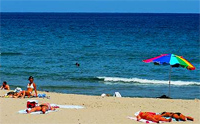 |
Florida... |
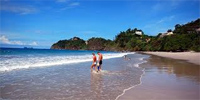 |
Costa Rica...and |
|
Massachusetts... oops, Sorry Amigos |
In Massachusetts, the "high" season ran just 14 weeks, Memorial Day to Labor Day, roughly corresponding to the summer school recess. In Florida and Costa Rica it's a bit longer, let's say early December to early May, although relatively good weather (i.e., relative to Massachusetts) can be enjoyed most of the year, although often only in the mornings during rainy season.
In Florida it gets a little chilly from December to March (GG often jokingly tells visitors I moved to Costa Rica because the winters in Florida were getting a little cold!) and it gets a little rainy in Costa Rica from May to December, particularly in October and November. A popular joke running around Sarasota was: "When the temperature drops below 80ºF, people put on a sweater; when it drops below 70, they put on a jacket and when it drops below 60, they go indoors because it must be a health emergency."
Good weather, that is summer weather, in the two U.S. locations mentioned, Massachusetts and Florida, brings on the hordes of tourists but at different times of the year. We see a similar invasion in our summer here which runs from mid-December to early May and parallels the Florida season. But there is one time of the year in Costa Rica where there is a particularly dramatic tourist surge. It results from a huge population shift, particularly to places like Quepos-Manuel Antonio and most of it comes from within the country, the central valley.
It happens at Semana Santa, also known as Holy Week or Easter Week; this is the week that runs from Palm Sunday (called Domingo de Ramos in Spanish) to Easter Sunday (called La Pascua). The entire week is a school holiday but technically only Holy Thursday and Good Friday are official holidays (remember that the official state religion here is Roman Catholic - at least at the moment). This year the holiday period ran from Friday, March 18, when government offices closed and banks went on skeleton staffing, to Easter Sunday, March 27, a full ten days. Nothing official moved on Thursday or Friday except security forces (all of which got to work the holiday as usual).
"Drive Responsibly-You're not going to be resurrected Sunday"
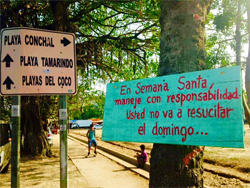 |
Semana Santa is not only considered an important holiday period in Costa Rica, like July 4th or Labor Day in the States, it is also traditional for many inlanders (read Central Valley dudes) to go to the beach, their favorite beach wherever it may be. Pacific beaches from the northwest corner of Costa Rica (Guanacaste) down through the Nicoya Peninsula and south to Jacó and down through Quepos, Dominical and the southern Pacific coast get invaded.
|
Avenida Segundo - Typical Day |
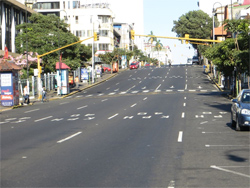 |
Avenida Segundo on Good Friday (Photo Courtesy Michael Miller) |
We're not talking about
a light traffic increase here. No town or village on the coast is exempt from the wave of humanity trying to reach the salted waters. My guess is half of the people in the central valley, the valley that is home normally to over 50% of the people in the country, escape to the Pacific shore, although some of them I'm sure also head for the mountains and the caribbean shore as well.
By Wednesday of Semana Santa, the major road artery leading out of San José, the Autopista San José-Caldera has been converted to one direction (west towards the beaches). The direction will be reversed on Easter Sunday as the invasion tries to get home, since most people need to be back to work on Monday. By Good Friday, San José, which normally is a bustling city (some might say too much so) has become a ghost town. Avenida Segundo, which could be thought of as the Broadway or 5th Avenue of San José is barren (see photos right).
The migration that occurs during Semana Santa reminds me of August in Brussels where I lived during the '70s. The entire month of August in Belgium was (still is?) designated as vacation month. We used to joke that in August there were more Belgians in Spain than in Belgium (not far from the truth). Many signs went up in windows announcing "Conjé Annuel" or annual vacation. That sign meant that there would be no business conducted for the whole month. The human exodus from Belgium was augmented by the Belgians receiving their annual, one-month bonus in July (Costa Ricans get their bonus, their "aguinaldo", just before Christmas, ). The metropolitan area of Brussels, about the same size as the central valley (1.8 million) also became a ghost town during the Conjé Annuel.
Following the end of Semana Santa always come the sad statistics, Too much physical interaction, driving aggression, alcohol and drug stimulation and carelessness have negative consequences. Costa Rica combines statistics for traffic accidents, gun shootings and other weapon aggressions, drownings and traffic accidents into one category with regard to fatalities; they call it violent deaths. Costa Rica was second only to Nicaragua in this category for this year's Semana Santa with 38 fatalities. The Costa Rican Cruz Roja (Red Cross) reported transferring 92 people to hospital with injuries or wounds in this category.
But the vast majority of the people got to enjoy some of the most beautiful beaches and wild country in the world. By Monday morning all was back to normal and GG went back to the beach to enjoy the scenery, warm waters and pacific breeze once more. The crowds were gone and only the regular number of tourists were present.
Ahhhhhhh, schweeet.
¡Solo Bueno!
TOP
Travel Quote of the Month
After landing: "Thank you for flying Delta Business Express. We hope you enjoyed giving us the business as much as we enjoyed taking you for a ride.” |
What's-in-a-Word
Answer to Que Es Eso?
.jpg)
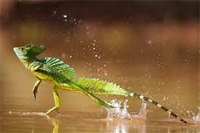 Why that's no gecko, it's a basilisk lizard, also known as a Jesus Christ Lizard or simply a Jesus Lizard. It's called that because of it's ability to use it's webbed feet and run so fast that it literally walks (or runs) on water.
Why that's no gecko, it's a basilisk lizard, also known as a Jesus Christ Lizard or simply a Jesus Lizard. It's called that because of it's ability to use it's webbed feet and run so fast that it literally walks (or runs) on water.
"Flaps between their toes help support the basilisk, creating a larger surface and a pocket of air." Basilisks are omnivores and live on a diet of plant material, insects, fruit, and small vertebrates. They are common in Central America and have reportedly been introduced to Florida.
The first time I saw one it was zipping across a pool at a hotel in Manuel Antonio. Dude, what a cool reptile.
Cacique
- Originally a tribal chief in the Spanish West Indies.
- A local political leader in Latin America.
- Any of a number of tropical blackbirds from Central America and South America, family Icteridae.
From the Taino *kasike (“chieftain”) or Arawak kassequa (“chieftain; power”), via Spanish cacique.The Tainos were a sub-group of the Arawaks and the latter were the predominate tribe in Cuba, Jamaica, Hispaniola (the Dominican Republic and Haiti), and Puerto Rico
.
TOP
ROMEO Corner
(Retired Old Men Eating Out)
P F Chang's - Escazu
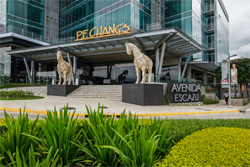 Location: On the corner of Avenue Escazu at the autopista about 30 meters east of CIMA Hospital
Location: On the corner of Avenue Escazu at the autopista about 30 meters east of CIMA Hospital
Hours: Lunch and Dinner Daily, 12-10 PM
Parking: Not readily apparent along the street but there is a large parking garage attached to CIMA that's a short walk away.
Contact: Tel.: 2208 8844; Email: avenidaescazu@pfchangs.cr ; Website: www.pfchangs.crReviewing ROMEOS: Mary M., Lance M., Brian M., Bob N.To Review Our Rating System and Procedure, go here:R.O.M.E.O. Rating System
Neither sleet nor snow (especially here) will keep ROMEOs from their appointed duty to check out restaurants wherever the R dudes go. Four of our group found ourselves in Escazu, known by some as the American Ghetto of Costa Rica, due to the number of gringo's there and relative affluence. After a doctor's appointment, we headed towards a nearby restaurant, P. F. Chang's.
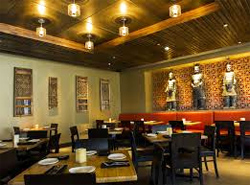 GG apparently now leads a more secluded life as the other three were all familiar with Chang's and I had never heard of them. A quick internet search revealed that they are a restaurant chain based in Scottsdale, Arizona with over 250 restaurants around the globe which they describe as "China-Bistro". They also have over 200 smaller, "fast-casual" dine-in restaurants under the name Pei-Wei ("pay-way") operating in separate locations including airports. The Escazu location falls into the China-Bistro format.
GG apparently now leads a more secluded life as the other three were all familiar with Chang's and I had never heard of them. A quick internet search revealed that they are a restaurant chain based in Scottsdale, Arizona with over 250 restaurants around the globe which they describe as "China-Bistro". They also have over 200 smaller, "fast-casual" dine-in restaurants under the name Pei-Wei ("pay-way") operating in separate locations including airports. The Escazu location falls into the China-Bistro format.
Bistro is a good description; sleek and modern with some, but not heavy, chinese accents for decoration. Well lit, padded chairs (I knew immediately I wasn't in Manuel Antonio); all of it made one feel immediately comfortable.
For atmosphere we gave P. F. Chang's a composite score of 4.1 sloths.
 The menu was quite extensive for lunch although I didn't stop to enquire if there was another menu for dinner, so it may have been for both. GG selected the seared tune salad (photo) and was presented with exactly what was in the picture mounded on vegetables and greens, some identifiable, some not but all fresh and delicious. The menu was quite extensive for lunch although I didn't stop to enquire if there was another menu for dinner, so it may have been for both. GG selected the seared tune salad (photo) and was presented with exactly what was in the picture mounded on vegetables and greens, some identifiable, some not but all fresh and delicious.
Another ROMEO had a version of steamed dumplings in an asian sauce which I got to sample, again delicious. Other ROMEOS had a mongolian beef and a "dynamite" shrimp (spice pink sauce), which I also delightfully sampled (it's good to be GG).
Our composite score for food was 4.9 (out of a max of 5.0).
|
 |
.jpg) .4 .4 |
$$$.8 |
Value Index = 116 |
We had a very efficient waiter who kept abreast of our needs and eye motions. We ended up with a composite score of 4.1 for service. That made our average composite score for atmosphere, food quality and service 4.4.
I forget what I paid for the seared tuna salad and a soft drink but that means it was unremarkable. The composite score from the group for cost was 3.8 and that yields a value index of 4.4/3.8x100=116, putting P.F. Chang's in the top 1/3 of value indexes on restaurants we have reviewed.
If you're in the CIMA Hospital area or even down the road a bit, like at the Multi-Plaza, P.F. Chang's is a good option for a meal.
Addendum: The same four ROMEOs found their way to Escazu some two weeks later for another medical appointment after that conclusion we headed once more for P.F. Chang's. We had an assortment of steamed dumplings, shrimp appetizers and shrimp main courses as well as a Thai all-vegetable dish. The second experience confirmed the ratings we gave it above.
Golden Gringo Chronicles Novel and E-Books Now Available!
 The story of the Golden Gringo Chronicles is also available as a hard copy novel of 192 pages available through Amazon and all major online retailers. ($9.95)
The story of the Golden Gringo Chronicles is also available as a hard copy novel of 192 pages available through Amazon and all major online retailers. ($9.95)
Amazon link: GGC, the Book. (Kindle Edition available)
Follow GG through the first six years of his odyssey in making the decision to retire in Costa Rica, overcoming the trials and tribulations of moving and obtaining residency there and the fun and experience of actually living in Ticoland.
Ride along with the Golden Gringo as he learns about the rich, varied culture of Costa Rica, the incredible bio diversity, the charming nature of the Costa Rican people and the ease with which a sometimes clueless ex-pat can assimilate into a small southwestern town on the Pacific coast.
Whether you are already a Costa Rican resident, someone contemplating a move here or just a traveler who enjoys different cultures, you will find the Golden Gringo Chronicles interesting, entertaining and informative about Costa Rica.
A narrative version of the Golden Gringo Chronicles is now also available as a trilogy of E-books in formats compatible with virtually all electronic platforms.
Part 1: (FREE!)
Leaving the Homeland
Part 2: ($3.99)
The Early Years
Part 3: ($3.99)
Becoming Tico, Maybe
Click on Part Number above for E-book sample downloads or click the price above right for purchase. (The best price is on Part 1; it's FREE)
Opt-In Here to Receive Your Free Copy Monthly
The Golden Gringo Chronicles is a free newsletter that is non-political, non-commercial and, hopefully, entertaining. By signing up you will receive an email each month around the first of the month giving you the links to the latest edition as well as to each individual feature and departmental section.
CLICK HERE TO SIGN-UP FOR THE
GOLDEN GRINGO CHRONICLES
or Email me at gg@goldengringo.com
Website: www.goldengringo.com

The Golden Gringo
Pura Vida!
To Contact GGC World Headquarters (yuk, yuk) to make comments, suggest topics or criticize my bad jokes, just send an email to: gg@goldengringo.com.
Be pithy but kind; I'm sensitive.
Unsubscribe from Golden Gringo Chronicles

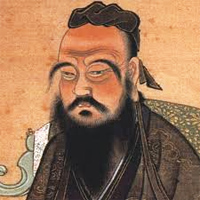 “The Master said, At fifteen I set my heart upon learning.
“The Master said, At fifteen I set my heart upon learning. 
 jetBlue Airways is a relative newcomer (2013) to Costa Rica (evidently their trademarked logo begins with a lower case "j" - I would think that must cause a little angst in some grammar circles). The airline keeps expanding its schedule here and now services both San José and Liberia international airports from New York and Ft. Liquordale (er, excuse, Ft. Lauderdale). To encourage jetBlue awareness of their service to Ticoland amongst customers and potential customers, a public relations promotion was recently done on a jetBlue flight from Boston to Phoenix.
jetBlue Airways is a relative newcomer (2013) to Costa Rica (evidently their trademarked logo begins with a lower case "j" - I would think that must cause a little angst in some grammar circles). The airline keeps expanding its schedule here and now services both San José and Liberia international airports from New York and Ft. Liquordale (er, excuse, Ft. Lauderdale). To encourage jetBlue awareness of their service to Ticoland amongst customers and potential customers, a public relations promotion was recently done on a jetBlue flight from Boston to Phoenix.
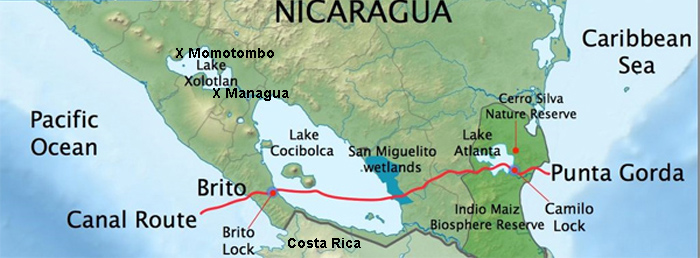

 There are a myriad of brands that are exported and many of them come from the Tarrazu region. Tarrazu is a canton (a canton is like a county and Tarrazu is a canton of San José province like Quepos is a canton of Puntarenas province). While other provinces produce their own variety of quality coffees, Tarrazu is considered the source of some of the best along with neighboring regions like Dota.
There are a myriad of brands that are exported and many of them come from the Tarrazu region. Tarrazu is a canton (a canton is like a county and Tarrazu is a canton of San José province like Quepos is a canton of Puntarenas province). While other provinces produce their own variety of quality coffees, Tarrazu is considered the source of some of the best along with neighboring regions like Dota.

















 In 1910, cacique Saldaña attended a funeral feast and he and his nephew, who was scheduled to succeed him, died by poisoning at the event. The official report stated that they died by drinking iodine accidentally but oral tradition among the indiginas claims it was intentional. There was never another cacique appointed after Saldaña. In 1939, the last cacique was honored by putting his image on the ten colon paper bill (one colon in 1939 was equal to $3.63, so ten would be $36+). This was before the civil war and some 9 years before the founding of the Costa Rican second republic, the basic government structure that continues to this day.
In 1910, cacique Saldaña attended a funeral feast and he and his nephew, who was scheduled to succeed him, died by poisoning at the event. The official report stated that they died by drinking iodine accidentally but oral tradition among the indiginas claims it was intentional. There was never another cacique appointed after Saldaña. In 1939, the last cacique was honored by putting his image on the ten colon paper bill (one colon in 1939 was equal to $3.63, so ten would be $36+). This was before the civil war and some 9 years before the founding of the Costa Rican second republic, the basic government structure that continues to this day.

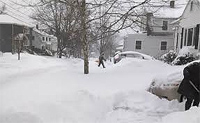

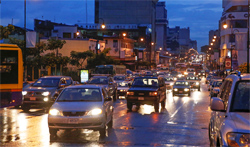

.jpg)
 Why that's no gecko, it's a basilisk lizard, also known as a Jesus Christ Lizard or simply a Jesus Lizard. It's called that because of it's ability to use it's webbed feet and run so fast that it literally walks (or runs) on water.
Why that's no gecko, it's a basilisk lizard, also known as a Jesus Christ Lizard or simply a Jesus Lizard. It's called that because of it's ability to use it's webbed feet and run so fast that it literally walks (or runs) on water. Location:
Location: GG apparently now leads a more secluded life as the other three were all familiar with Chang's and I had never heard of them. A quick internet search revealed that they are a restaurant chain based in Scottsdale, Arizona with over 250 restaurants around the globe which they describe as "China-Bistro". They also have over 200 smaller, "fast-casual" dine-in restaurants under the name Pei-Wei ("pay-way") operating in separate locations including airports. The Escazu location falls into the China-Bistro format.
GG apparently now leads a more secluded life as the other three were all familiar with Chang's and I had never heard of them. A quick internet search revealed that they are a restaurant chain based in Scottsdale, Arizona with over 250 restaurants around the globe which they describe as "China-Bistro". They also have over 200 smaller, "fast-casual" dine-in restaurants under the name Pei-Wei ("pay-way") operating in separate locations including airports. The Escazu location falls into the China-Bistro format. The menu was quite extensive for lunch although I didn't stop to enquire if there was another menu for dinner, so it may have been for both. GG selected the seared tune salad (photo) and was presented with exactly what was in the picture mounded on vegetables and greens, some identifiable, some not but all fresh and delicious.
The menu was quite extensive for lunch although I didn't stop to enquire if there was another menu for dinner, so it may have been for both. GG selected the seared tune salad (photo) and was presented with exactly what was in the picture mounded on vegetables and greens, some identifiable, some not but all fresh and delicious.




